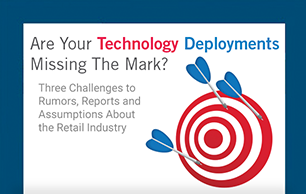
In QSR and retail, the race isn’t just to secure the right corner or shopping center. It’s to open fast, with everything working on day one.
The best site selection decisions don’t just set the stage for guest access and visibility, they also determine how smoothly IT systems, infrastructure, and equipment can be deployed.
From connectivity and power capacity to drive-thru readiness and digital ordering flow, smart site selection is the foundation that accelerates both construction and technology rollouts, helping brands capture revenue sooner and avoid costly delays.
1. Start with data, then validate on the ground
Analytics point you to the right trade areas, but they cannot answer every question. Demographics, traffic counts, and mobile data frame demand potential, yet success depends on verifying how a site actually functions.
The most forward-looking real estate teams use those same data models to forecast technology needs such as connectivity, POS volume, and digital ordering demand, ensuring IT and construction can move in sync.
2. Define the guest, then find the address
Winning locations start with a clear picture of who the customer is and when they show up. Families, students, and working professionals use restaurants differently, and the best sites are matched to those patterns.
Guest profiles also influence the technology blueprint. A family-heavy trade area may require kiosks and digital menu boards, while younger markets lean on app-based pickup and drive-thru flow.
3. Visibility and access are nonnegotiable
If a guest cannot find you or easily pull in and out, the rest of the investment suffers. Real estate leaders know that being on the right corner with strong sightlines is worth the premium.
That same visibility drives awareness for loyalty programs and digital promotions, while ease of access ensures that drive-thru lanes, curbside pickup, and order-ahead traffic can flow without bottlenecks.
4. Speed to market is a competitive advantage
Relationships with landlords and brokers often determine who secures prime sites. But speed is not just about lease signing. It’s about being ready to design, build, and open without delays.
When IT infrastructure is factored into site planning early, installations can run in parallel with construction instead of becoming last-minute roadblocks, allowing brands to capture revenue weeks or months sooner.
5. Account for hidden costs and time drains
A site that looks ideal can hide major complications. Electrical upgrades, HVAC capacity, zoning restrictions, or traffic studies can add months and hundreds of thousands of dollars to a project.
These issues affect not just construction but also IT readiness. Inadequate power can block kiosk or kitchen equipment installs, and permitting delays slow down network buildouts, POS deployment, and digital menu boards.
6. Future-proof for drive-thru and digital growth
Consumer behavior keeps shifting, and the right site today must leave room for tomorrow. Drive-thru-only models, order-ahead pickup, curbside lanes, and robotics are already reshaping formats.
The smartest sites allow flexibility to expand drive-thru capacity, add pickup lanes, or redesign interior flow for new equipment, ensuring technology and operations can evolve without costly remodels.
7. Keep site selection connected after opening
Too often, real estate hands off the project at lease signing. The most successful brands keep site selection linked to operations, marketing, and IT long after the doors open.
Real estate insights should inform rollout playbooks, while performance data from loyalty adoption, digital orders, and guest satisfaction should feed back into future site models, making every new location smarter and faster to launch.
Conclusion
Site selection defines how fast you can grow and how smoothly technology will scale across the fleet. Real estate leaders who blend data with local insights, plan for IT readiness from day one, and build for flexibility give their brands an edge that lasts far beyond opening day.
At this point, the right partner makes the difference. Telaid helps by designing, deploying, and supporting the integrated technology that turns strategy into reality across hundreds or thousands of locations. Ready to move faster? Let’s map a path from site selection to store launch.
Get the step-by-step guide to planning faster tech rollouts.
Download Chapter 1 of the Rollout Readiness Framework below to build a technology rollout plan your leadership team can say yes to.




